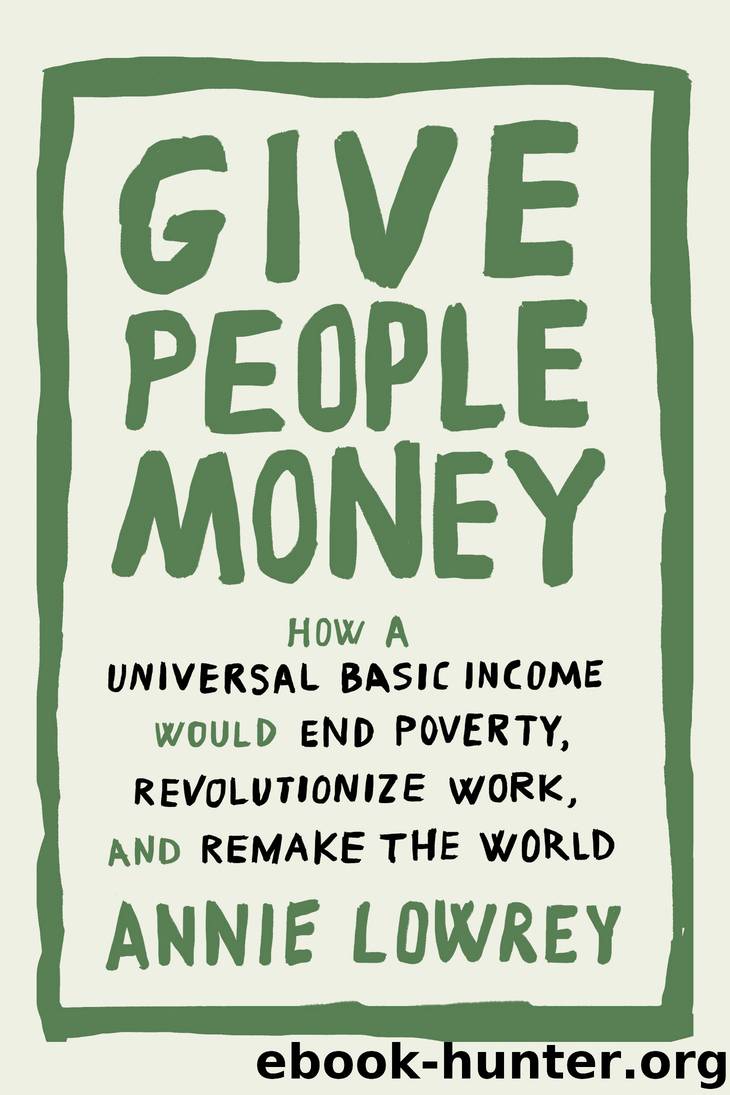Give People Money by Annie Lowrey

Author:Annie Lowrey
Language: eng
Format: epub
Publisher: Crown/Archetype
Published: 2018-07-09T16:00:00+00:00
* * *
The problem with the welfare state, the libertarian Charles Murray told me, is twofold: that the United States manages to leave millions of people in poverty, and that it manages to spend significant amounts of money doing so. His is the libertarian case for a UBI, one also made by Friedrich Hayek and Milton Friedman. Indeed, Hayek pushed for a “certain minimum income for everyone,” as a “floor below which nobody need fall even when he is unable to provide for himself.” Friedman advocated for a negative income tax, the proposal later taken up by Nixon. “Let us place a floor under the income of every family with children in America,” Nixon said in his 1971 State of the Union address, “and without those demeaning, soul-stifling affronts to human dignity that so blight the lives of welfare children today.”
For more than two decades, Murray has called for eliminating the existing welfare state—Medicare, Medicaid, Social Security, welfare, Section 8, all of it, as well as corporate giveaways and subsidies for agriculture—and replacing it with an $833-a-month credit. It is “our only hope to deal with a coming labor market unlike any in human history,” he argues. “It represents our best hope to revitalize American civil society,” by making people more responsible for their own thriving, without government interference. And it would push people to rely more on one another and less on the government teat. “Government agencies are the worst of all mechanisms for dealing with human needs. They are necessarily bound by rules applied uniformly to people who have the same problems on paper but who will respond differently to different forms of help,” he has written.
There are, however, a few problems with Murray’s approach. He is right that there are a considerable number of antipoverty programs in the United States, and that they can be confusing to use and in some cases difficult to administer. But their overhead costs are generally quite low. All of the major antipoverty programs—SNAP, Medicaid, housing vouchers, Supplemental Security Income, the EITC, and the school-lunch program, among others—spend a minimum of 90 cents on the dollar directly on benefits. Most spend far more than that. The Social Security system spends more than 99 cents of every dollar on benefits. There just is not that much money to be saved by streamlining overhead.
Second, eliminating the country’s existing antipoverty programs and converting them to a UBI without making other changes to the safety net would likely result in an increase in poverty. The math is straightforward. Getting rid of all means-tested initiatives, save for those that provide or subsidize health insurance, would raise about $1,582 per person per year, the economist Ed Dolan has estimated. That, by itself, would not lift anyone above the poverty line. Murray himself suggests giving each American $13,000 a year and requiring that $3,000 of it be spent on health insurance. He also envisions reducing the grant to $6,500 a year for people earning more than $60,000 a year. Still, under that system, millions of lower-income families might end up worse off.
Download
This site does not store any files on its server. We only index and link to content provided by other sites. Please contact the content providers to delete copyright contents if any and email us, we'll remove relevant links or contents immediately.
| Anthropology | Archaeology |
| Philosophy | Politics & Government |
| Social Sciences | Sociology |
| Women's Studies |
Nudge - Improving Decisions about Health, Wealth, and Happiness by Thaler Sunstein(7242)
iGen by Jean M. Twenge(5161)
The Fire Next Time by James Baldwin(5016)
Adulting by Kelly Williams Brown(4232)
The Hacking of the American Mind by Robert H. Lustig(4085)
The Sports Rules Book by Human Kinetics(4078)
The Ethical Slut by Janet W. Hardy(4040)
Captivate by Vanessa Van Edwards(3722)
Mummy Knew by Lisa James(3520)
In a Sunburned Country by Bill Bryson(3364)
The Worm at the Core by Sheldon Solomon(3325)
Ants Among Elephants by Sujatha Gidla(3279)
Suicide: A Study in Sociology by Emile Durkheim(2903)
The Slow Fix: Solve Problems, Work Smarter, and Live Better In a World Addicted to Speed by Carl Honore(2837)
The 48 laws of power by Robert Greene & Joost Elffers(2804)
Humans of New York by Brandon Stanton(2687)
Handbook of Forensic Sociology and Psychology by Stephen J. Morewitz & Mark L. Goldstein(2603)
The Happy Hooker by Xaviera Hollander(2583)
The Tipping Point by Malcolm Gladwell(2557)
